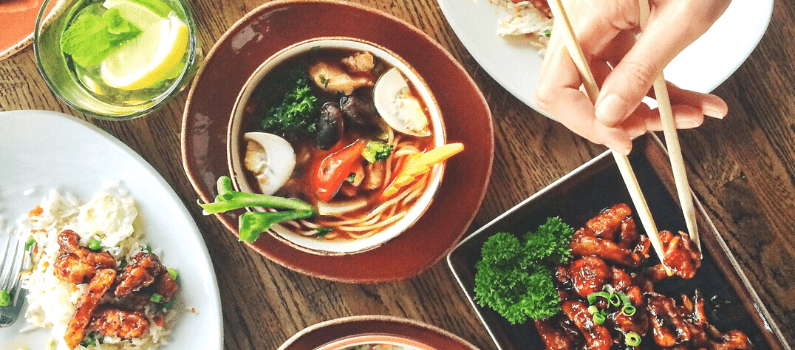After an unprecedented 2021, 2022 is shaping up to be another exciting and unique year for the food and beverage industry, with significant consumer interest and pressure mounting for adventure and experience on one hand; and transparent industry practices and innovations that reduce waste, save water, and place environmental impact at the center, on the other. With all that’s happening, we couldn’t wait any longer to share with you what we predict will be the top 10 food industry trends for 2022.
Not yet convinced that this is what 2022 has in store? Let the data convince you: Innova’s Global Lifestyle & Attitude report shows that – when asked what concerns consumers the most – “Health of the Planet” ranked #1, outpacing their top 2020 concern: “Health of the Population.” So, from Innova’s Innova Market Insights’ Top Ten Trends for 2022 report, we explore their top 10 food industry trends for 2022:
1. Shared Planet
Consumers are no longer content to place environmental responsibility solely with the individual – they are now actively seeking out food products and services from companies they deem environmentally responsible, as well.
Trust and transparency are key for brands seeking ways to stand up to the scrutiny and help consumers make responsible choices along the way. One tool that may help brands on this journey is the growing consumer demand for a singular, global Eco Score label that communicates nutritive and environmental claims with a simpler, easier-to-understand format.

2. Plant-Based: The Canvas for Innovation
As brands create the next generation of plant-based foods, nutrition and sustainability are playing bigger roles than in previous years. When asked “For what reasons would you consider plant-based alternatives,” consumers pointed to the fact that plant-based products are 1) Healthier and 2) Better for the planet (up from the #3 spot a year ago).
As we hear more in the media about plant-based innovation and sustainability – and see more plant-based products popping up everywhere from big name to discount grocery shelves as well as fast food to high-end restaurants — consumers will certainly be thinking more about these products as well as demanding more from them when it comes to taste. Food manufacturers can expect to see an increase in the need to recreate the authentic taste and mouthfeel of dairy in plant-based and vegan products.
3. Tech to Table
Technological advances have created serious innovation opportunities for the entire food and beverage industry, giving birth to new products such as cellular-based foods and protein derived from air, and even services like personalized nutrition.
A whopping 40% of consumers agree with the statement “I am more open to new technologies now that I have seen where it has brought plant-based innovation.” Furthermore, 50% believe cell-based tech can be the future of the food industry.
With the news of celebrities like Leonardo DiCaprio investing in cell-based meat start-ups such as Mosa Meat and Aleph Farms, we’re predicting a giant advancement in the cultivated meat market in 2022.

4. Shifting Eating Occasions
The pandemic reshaped existing eating occasions and helped create new ones around tech, and as a result, consumers now expect more from going out. While brands like Oatly collaborated with Starbucks to bring the out-of-home (OOH) in, consumers leveraged technology to help satisfy “safer” OOH eating environments during the pandemic, with QR-code menus pulled up on phones and touchless technology for curbside pick-up.
The concepts proved so popular that 50% of consumers globally say they are interested in trying new tech delivery concepts such as drone delivery, <5min delivery, and more.
Seeking elevated experiences that bring something extra to the eating experience will also be top of mind for consumers going forward, as we continue to spend more time in our homes. Case in point: 60% of global consumers polled by Innova say they expect more food brands to develop services that bring enhanced social connection into their homes.
5. Voice of the Consumer
Consumers are calling the shots, and they expect more engagement from brands through the digital and real-world channels they frequent. Approximately 75% of those surveyed told Innova that companies should listen to consumers more when developing new products, flavors, or strategies.
The European Institute of Innovation and Technology is one institution that is listening, actively trying to recruit stakeholders from younger generations to help shape the future of food innovation. And they are right on-trend with this move, as 64% of young people say they actively want to pursue a career in improving food innovation.
Engaging Gen Z through communication is critical to a food brand’s survival, as this generation is accustomed to having a constant personal connection with brands through social media. More and more, these consumers are looking for food and beverages that align with their political, social and ethical values. Therefore, transparent contact information, printed clearly on product labels; engaging consumers by allowing them to vote on the next flavor of your product; or showing a willingness to be brave by broaching a conversation about a complex issue affecting your product will go far in 2022.
For F&B Manufacturers, this means choosing suppliers and partners that can provide not only solutions but insights into consumer voice respective to their areas of expertise (and, if you’re looking for a flavor company that does just that, you’ve already found us!).

6. Gut Health
With foods’ role in consumer health being brought to the forefront in during the pandemic, it’s not surprising that 2 in 3 consumers now believe that gut health is the key to unlocking holistic wellbeing. When asked “To what extent do you think are the following physical health aspects influenced by gut health,” consumers reported feeling strongly that immune health and energy levels were impacted by their gut.
While it’s true that consumers don’t always know best when it comes to which ingredients will have the biggest impact on their health and wellness, they are attentively listening. Successful brands will be those who can foster conversations that help them have a better understanding of the full potential of ingredients on their health.
7. Back to the Roots
Consumers increasingly value the functionality, freshness, and authenticity of local foods. When asked “If you have bought/sourced more local produce in the past 12 months, to what extent do you expect to continue after the pandemic,” the majority of consumers polled answered “More” or “Much more”.
Even more intriguing, the importance of freshness increased by 9 points over the last year, driven in part by increased in-home eating during the pandemic.
From farm-fresh locally sourced foods to large, globally recognized products, brands are delivering on this trend in a number of ways. We’re seeing everything from companies taking advantage of their label to tell a story about where their product and its ingredients come from, to leveraging regional taste profiles in both globally and regionally launched products.

8. Amplified Experiences, Amplified by the Pandemic
Hungry for new experiences around food, 50% of consumers polled said: “I want to be more adventurous with my food and beverage choices” post-pandemic. To answer the call, the brands we know and love have developed new, attention-grabbing products.
Coors has capitalized on the seltzer trend with a breakthrough Coors Seltzer Orange Cream Pop; then expanded on that trend with a Seltzer Orange Cream Pop ice cream. Cup Noodles has developed a new fizzy beverage. Budweiser launched its own popcorn in the UK. And Unilever’s Magnum Ice Cream launched new flavors in Australia inspired by New York, Tahiti and Amsterdam, accompanied by an ad campaign featuring travel posters.
Mixing things up with flavors – whether flavor layering or introducing new tastes by leveraging regional profiles – is a great way for product developers to meet consumer demand for more adventurous experiences in 2022.
9. Upcycling Redefined
As we focus our sights back on the environment, we’re noticing a trend of ingredients that were once considered throwaways, now being given a new lease on life.
In fact, in 2021 there was a 54% growth among food and beverage launches with an upcycling claim. These include coffee grounds in skin care and spent grain from breweries being upcycled to make keto flour. Beverage brand Super Frau makes a fizzy beverage that’s even made with fresh, upcycled whey. Innova found that 35% of consumers say that products with upcycled ingredients are more appealing than other products, not just because of sustainability, but also due to the perceived health benefits and freshness.
10. My Food, My Brand
Like everything else they choose to purchase, Gen Z considers its food to be reflective of its personal brand, lifestyle, and values.
When asked about the importance of specific values to their diet, 62% of consumers polled chose humanitarianism, 56% chose inclusivity, and 53% chose diversity. No longer is food simply about consumption, but rather, brands are expected to create connections and reflect consumers’ personal and social beliefs and values.
The challenges and opportunities 2022’s food trends present are incredibly focused this year, yet offer unlimited potential for creative, innovative brands to take advantage.
How Can F&B Manufacturers Leverage the Top 10 Food Industry Trends for 2022?
What will the next year look like for you? Let’s define the future together. As the New Year starts, not all industry trends are ‘new’ but the F&B manufacturers who can leverage these top 10 food industry trends for 2022 to meet consumer demand will be best positioned to gain market share in an ever competitive and crowded space.
“The pandemic has left its mark on consumers, and we are seeing this reflected in just how important food and beverage choices are now when it comes to them prioritizing their health,” says Anne Marie Butler, Edlong’s Global Director of Innovation and Commercial Development. “Meals in general have become both a place of connection for family and friends, an opportunity to explore new things and ‘travel’ safely, and have also empowered us to improve our personal health and our shared planet’s health with the choices we make.”
“In the year ahead, I feel that we, as consumers, will continue to strive to find a balance between healthy and nutritious, good for the planet, and great tasting,” she continued.
“The responsibility to ensure we meet these demands while still delivering authentic, rich and delicious taste is not taken lightly at Edlong. We understand the assignment, and continually strive to build on our 100+ years of our success,” she says.
Interested in learning more about how to give your 2022 new launches a competitive edge? Reach out today to our global team of R&D Flavorists and Applications experts to take
Topics: Clean labelDairy flavorsDairy-freeHealthy ReductionPlant-BasedVegan
Resource Type: Article